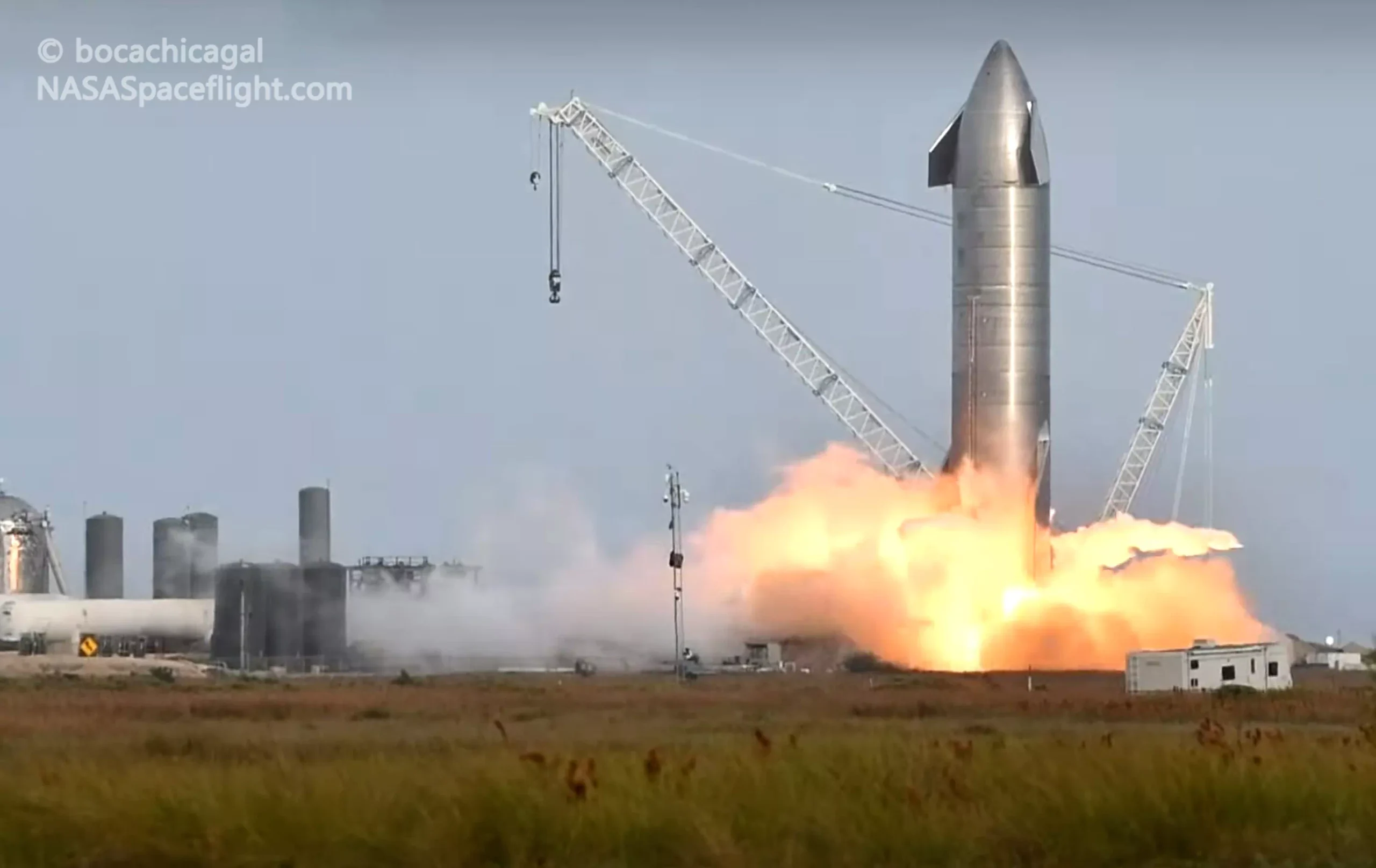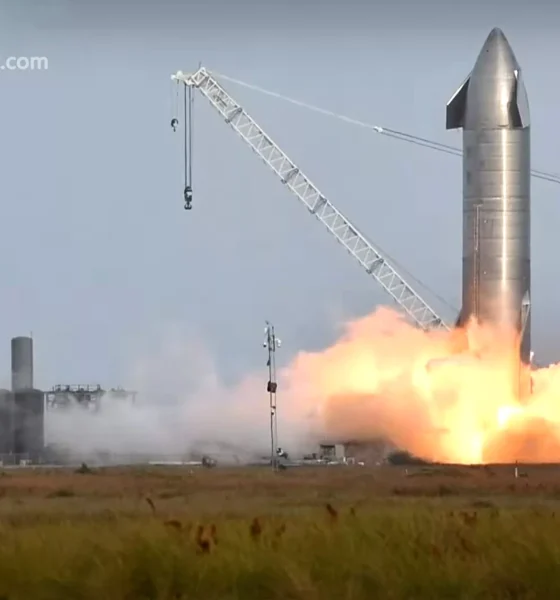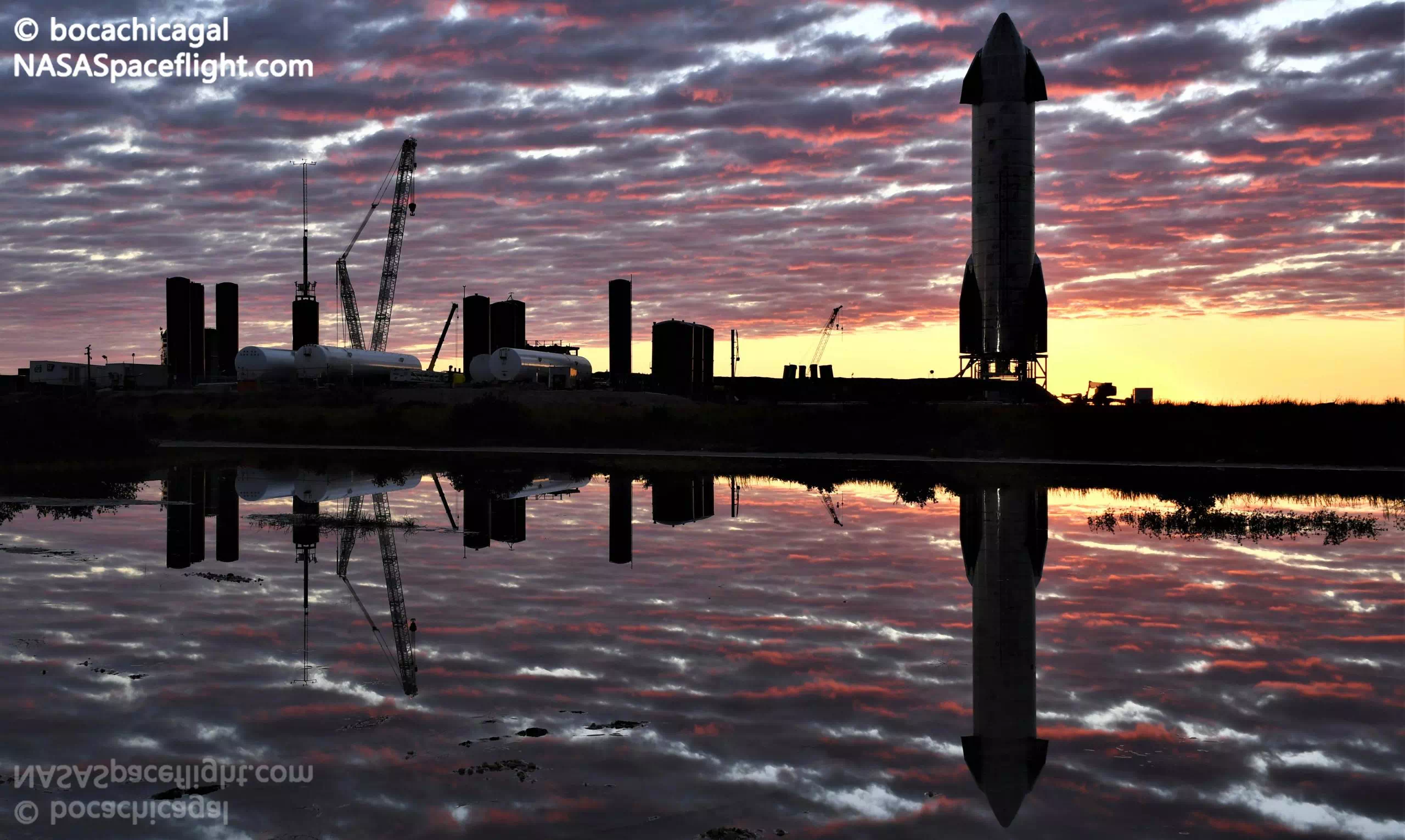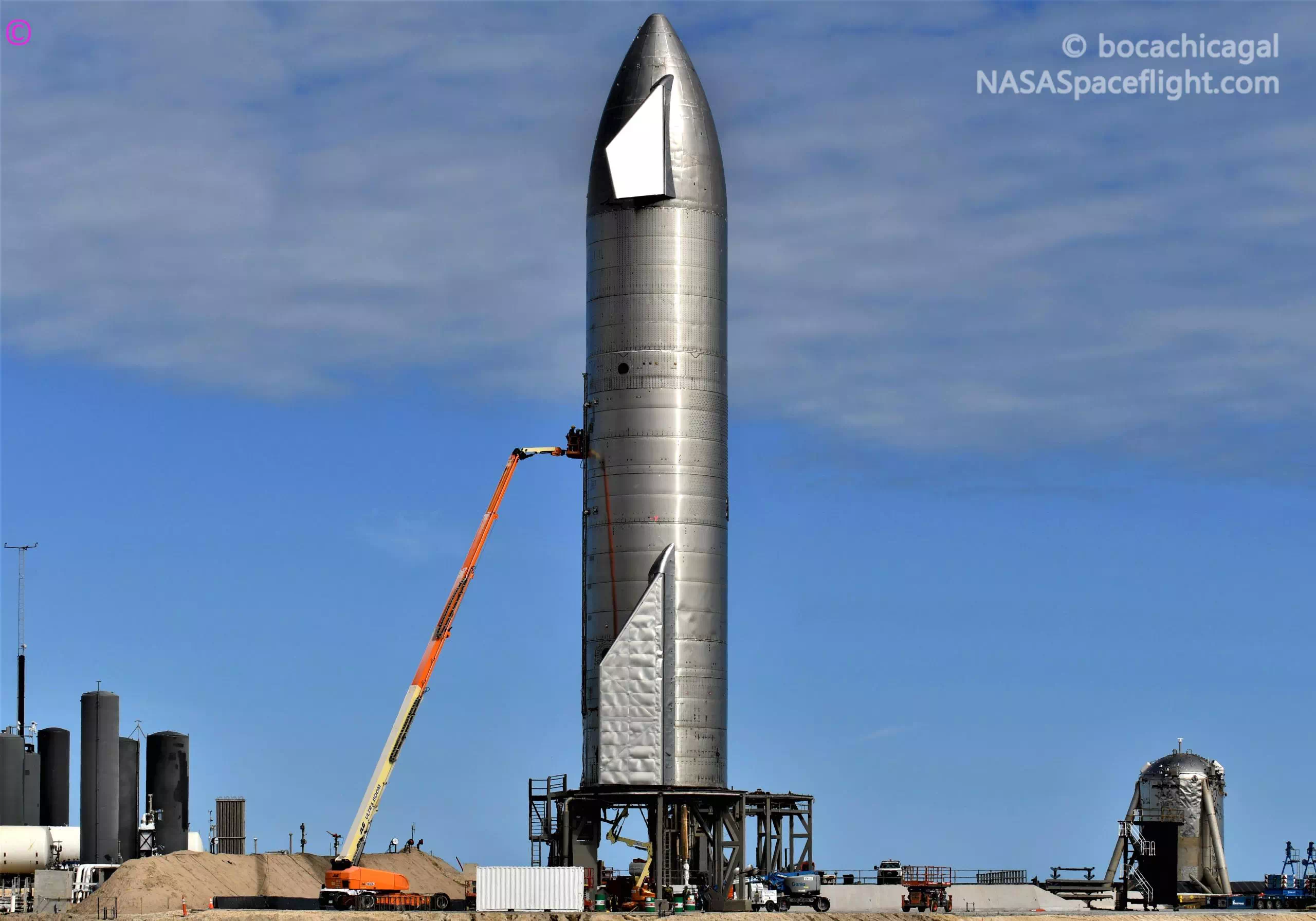

News
SpaceX schedules second Starship static fire after first test ends prematurely
Update: SpaceX appears to have plans for a second triple-Raptor static fire for Starship SN9 after the rocket’s first test was cut short for unknown reasons.
Identical to previous road closure windows, SpaceX will have an opportunity to test Starship SN9 from 8 am to 5 pm CST (UTC-6) on Friday, January 8th, potentially paving the way for a high-altitude launch attempt early next week if the second static fire goes as planned. Stay tuned for updates!
In what is likely one of the last steps before SpaceX’s next high-altitude Starship launch attempt, the company appeared to successfully put Starship serial number 9 (SN9) through its first triple-Raptor static fire test.
Relatively late into a test window that opened at 8 am CST (UTC-6) but was later pushed to noon, SpaceX’s first Starship SN9 static fire attempt began in earnest around 3:15 pm CST. Signified by venting activity at the propellant farm tasked with preparing and loading liquid oxygen and methane on Starships, slight tweaks in the test flow were observed but the static fire occurred more or less when expected at 4:07 pm.
SN9 ignited all three of its Raptors in quick succession and shut the engines down over the course of 1.5-2 seconds – extremely short relative to all previous nominal Starhopper or Starship-mounted Raptor static fires. Long-time followers immediately noted that small discrepancy, speculating that it could either have been a post-ignition abort or intentionally shortened to avoid damaging the pad’s concrete surface (an incident that’s occurred several times during recent tests).
Not long before the short static fire, SpaceX extended the end of its January 6th test window (in the form of road closure notices) from 5 pm to 8 pm. Oddly, rather than the expected response of detanking Starship and reopening the road after a successful test, SpaceX essentially recycled SN9 and began a separate test around 6 pm. The road was never reopened and a SpaceX team never headed back to the pad between the tests, implying that the company may have run into a minor hardware or software bug earlier in the day.
It’s unclear what the actual goal of the second attempt was and it’s more or less impossible to know for sure with confirmation from CEO Elon Musk. It’s possible – if unlikely – that the first static fire went exactly as planned and the follow-up test was meant to be a simple data-gathering wet dress rehearsal (WDR). Either way, after a surprise downpour briefly engulfed Starship SN9 minutes prior, the second test appeared to abort about 30 minutes into propellant conditioning and loading, precluding both a complete WDR and/or static fire.


According to a test notice received on January 6th by NASASpaceflight contributer and photographer Mary (bocachicagal), SpaceX has another test window available on January 7th in the event that Wednesday’s testing was partially unsuccessful. In a rare case, SpaceX’s hand-distributed warning for residents preceded any additional planned road closures, the last of which lifted on January 6th.
On January 5th, SpaceX received a trio of Temporary Flight Restrictions (TFRs) from the FAA that will allow the company to restrict access to nearby airspace for high-altitude Starship launch attempts on January 8th, 9th, and 10th. Lacking an unequivocally successful static fire, it’s highly unlikely – but not impossible – that Starship will be ready for a launch attempt during any of those three windows. Still, it’s safe to say that SN9 is probably less than a week away from its first flight – expected to be a carbon copy of SN8’s 12.5 km (7.8 mi) launch and landing attempt – if SpaceX can complete a full-duration static fire in the next day or two.

Elon Musk
Elon Musk’s X will start using a Tesla-like software update strategy
The initiative seems designed to accelerate updates to the social media platform, while maintaining maximum transparency.

Elon Musk’s social media platform X will adopt a Tesla-esque approach to software updates for its algorithm.
The initiative seems designed to accelerate updates to the social media platform, while maintaining maximum transparency.
X’s updates to its updates
As per Musk in a post on X, the social media company will be making a new algorithm to determine what organic and advertising posts are recommended to users. These updates would then be repeated every four weeks.
“We will make the new 𝕏 algorithm, including all code used to determine what organic and advertising posts are recommended to users, open source in 7 days. This will be repeated every 4 weeks, with comprehensive developer notes, to help you understand what changed,” Musk wrote in his post.
The initiative somewhat mirrors Tesla’s over-the-air update model, where vehicle software is regularly refined and pushed to users with detailed release notes. This should allow users to better understand the details of X’s every update and foster a healthy feedback loop for the social media platform.
xAI and X
X, formerly Twitter, has been acquired by Elon Musk’s artificial intelligence startup, xAI last year. Since then, xAI has seen a rapid rise in valuation. Following the company’s the company’s upsized $20 billion Series E funding round, estimates now suggest that xAI is worth tens about $230 to $235 billion. That’s several times larger than Tesla when Elon Musk received his controversial 2018 CEO Performance Award.
As per xAI, the Series E funding round attracted a diverse group of investors, including Valor Equity Partners, Stepstone Group, Fidelity Management & Research Company, Qatar Investment Authority, MGX, and Baron Capital Group, among others. Strategic partners NVIDIA and Cisco Investments also continued support for building the world’s largest GPU clusters.
News
Tesla FSD Supervised wins MotorTrend’s Best Driver Assistance Award
The decision marks a notable reversal for the publication from prior years, with judges citing major real-world improvements that pushed Tesla’s latest FSD software ahead of every competing ADAS system.

Tesla’s Full Self-Driving (Supervised) system has been named the best driver-assistance technology on the market, earning top honors at the 2026 MotorTrend Best Tech Awards.
The decision marks a notable reversal for the publication from prior years, with judges citing major real-world improvements that pushed Tesla’s latest FSD software ahead of every competing ADAS system. And it wasn’t even close.
MotorTrend reverses course
MotorTrend awarded Tesla FSD (Supervised) its 2026 Best Tech Driver Assistance title after extensive testing of the latest v14 software. The publication acknowledged that it had previously criticized earlier versions of FSD for erratic behavior and near-miss incidents, ultimately favoring rivals such as GM’s Super Cruise in earlier evaluations.
According to MotorTrend, the newest iteration of FSD resolved many of those shortcomings. Testers said v14 showed far smoother behavior in complex urban scenarios, including unprotected left turns, traffic circles, emergency vehicles, and dense city streets. While the system still requires constant driver supervision, judges concluded that no other advanced driver-assistance system currently matches its breadth of capability.
Unlike rival systems that rely on combinations of cameras, radar, lidar, and mapped highways, Tesla’s FSD operates using a camera-only approach and is capable of driving on city streets, rural roads, and freeways. MotorTrend stated that pure utility, the ability to handle nearly all road types, ultimately separated FSD from competitors like Ford BlueCruise, GM Super Cruise, and BMW’s Highway Assistant.
High cost and high capability
MotorTrend also addressed FSD’s pricing, which remains significantly higher than rival systems. Tesla currently charges $8,000 for a one-time purchase or $99 per month for a subscription, compared with far lower upfront and subscription costs from other automakers. The publication noted that the premium is justified given FSD’s unmatched scope and continuous software evolution.
Safety remained a central focus of the evaluation. While testers reported collision-free operation over thousands of miles, they noted ongoing concerns around FSD’s configurable driving modes, including options that allow aggressive driving and speeds beyond posted limits. MotorTrend emphasized that, like all Level 2 systems, FSD still depends on a fully attentive human driver at all times.
Despite those caveats, the publication concluded that Tesla’s rapid software progress fundamentally reshaped the competitive landscape. For drivers seeking the most capable hands-on driver-assistance system available today, MotorTrend concluded Tesla FSD (Supervised) now stands alone at the top.
News
Elon Musk’s Grokipedia surges to 5.6M articles, almost 79% of English Wikipedia
The explosive growth marks a major milestone for the AI-powered online encyclopedia, which was launched by Elon Musk’s xAI just months ago.

Elon Musk’s Grokipedia has grown to an impressive 5,615,201 articles as of today, closing in on 79% of the English Wikipedia’s current total of 7,119,376 articles.
The explosive growth marks a major milestone for the AI-powered online encyclopedia, which was launched by Elon Musk’s xAI just months ago. Needless to say, it would only be a matter of time before Grokipedia exceeds English Wikipedia in sheer volume.
Grokipedia’s rapid growth
xAI’s vision for Grokipedia emphasizes neutrality, while Grok’s reasoning capabilities allow for fast drafting and fact-checking. When Elon Musk announced the initiative in late September 2025, he noted that Grokipedia would be an improvement to Wikipedia because it would be designed to avoid bias.
At the time, Musk noted that Grokipedia “is a necessary step towards the xAI goal of understanding the Universe.”
Grokipedia was launched in late October, and while xAI was careful to list it only as Version 0.1 at the time, the online encyclopedia immediately earned praise. Wikipedia co-founder Larry Sanger highlighted the project’s innovative approach, noting how it leverages AI to fill knowledge gaps and enable rapid updates. Netizens also observed how Grokipedia tends to present articles in a more objective manner compared to Wikipedia, which is edited by humans.
Elon Musk’s ambitious plans
With 5,615,201 total articles, Grokipedia has now grown to almost 79% of English Wikipedia’s article base. This is incredibly quick, though Grokipedia remains text-only for now. xAI, for its part, has now updated the online encyclopedia’s iteration to v0.2.
Elon Musk has shared bold ideas for Grokipedia, including sending a record of the entire knowledge base to space as part of xAI’s mission to preserve and expand human understanding. At some point, Musk stated that Grokipedia will be renamed to Encyclopedia Galactica, and it will be sent to the cosmos.
“When Grokipedia is good enough (long way to go), we will change the name to Encyclopedia Galactica. It will be an open source distillation of all knowledge, including audio, images and video. Join xAI to help build the sci-fi version of the Library of Alexandria!” Musk wrote, adding in a later post that “Copies will be etched in stone and sent to the Moon, Mars and beyond. This time, it will not be lost.”








